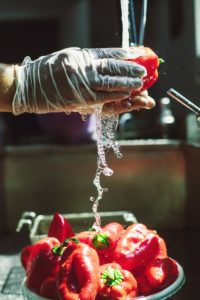
Fruits are an important part of every balanced, healthy diet. If you eat a lot of fruits and vegetables, you probably know that they are grown with the help of pesticides. Unfortunately, those pesticides remain on the skin of the produce even after picking. It is important to remove those prior to eating any fruits and vegetables.
In this article, we will talk about which fruits and vegetables have more pesticides than others, what are the best ways in which you can remove them, and how to do that in the best, most efficient way.
Of course, buying organic produce is the easiest way to reduce the number of pesticides on your fruits, however, it can be cost-prohibitive to regularly buy organic produce. Lucky for you, all pesticides can be easily removed from the skin of your fruits and vegetables only using common household products.
How to remove pesticides in the best way?
Most people simply wash their fruits with plain tap water. While this will remove some of the pesticides from the fruit, further cleaning will be needed. Baking soda, in fact, is one of the best products that will get rid of most of the pesticides from the fruits and vegetables you have. Now, there are different methods you can use, depending on the amount of product you are about to wash. Keep in mind that it is best to do that right before eating/cooking your vegetables or fruits. Washing them earlier may cause them to go bad faster.
In the sink
1. Always wash your hands first. Use warm water and soap to remove any dirt and germs and prevent spreading them on your fruits or vegetables.
2. Ideally, you should clean your sink as well. It is best to use a natural product and thoroughly clean it to remove any dirt, germs, and food residue.
3. Fill your sink with cold water (halfway full would be enough).
4. Add 3 tablespoons of bicarbonate soda and let it properly dissolve into the water.
5. Place all your fruits and vegetables in the sink, let them soak for 15-20 minutes, then follow the instructions below for washing specific fruits and vegetables.
6. Finally, remove all products from the water and let it dry before consuming.
In a bowl – You can use the same method for fewer fruits and vegetables in a bowl. The only difference is that you should take note of how much water your bowl holds. For every 500ml of water, add 1 tablespoon of bicarbonate soda.
How to wash different fruits and vegetables
Leafy vegetables like lettuce or cabbage are best separated into their individual leaves prior to washing. That way, the bicarbonate soda will be able to get into all nooks and crannies of the leaves.
Soft fruits and vegetables like strawberries, tomatoes, or grapes should be slightly rubbed (best use your fingers). That way you will remove all pesticides from their surface without causing damage.
Firm fruits and vegetables like melons, cucumbers, carrots, and apples can be gently scrubbed with a sponge or a soft-bristled vegetable brush.
Cleaning pesticides that are able to penetrate the skin of the fruit or vegetable.
Washing fruits (like apples) with bicarbonate soda will remove most of the pesticides that can be found on their skin. However, some of them are able to penetrate it. Removing the skin will ensure better cleaning of your fruits. Keep in mind that more than 70% of the vitamin E and vitamin K found in apples are contained in their skin. There are also a lot of nutrients, iron, and folic acid found in the skin of the apple. That being said, simply washing the surface of your fruits is sufficient.
Why is soaking important?
When cleaning your fruits or vegetables, it is recommended that you soak them for 12-15 minutes. While this may not be the most practical, it is the most efficient way to loosen up the pesticides from their surface and properly get rid of them. Do not skip this part and enjoy healthier fruits and vegetables.
Why are pesticides used on fruits and vegetables?
There are a number of reasons for the use of pesticides on fruits and vegetables. They help them grow protected from plant diseases and pests. They also control weeds and insects that can damage or destroy food crops.
However, pesticides are not all good. They can actually contaminate land, water, and other plants. They can also kill precious pollinators such as bees, birds, and fish. What is more, they can harm farm workers and local communities.
Make sure you take the time to properly clean your fruits and vegetables and if you want to help reduce the use of harmful pesticides, check for campaigns that promote safe and sustainable alternatives to hazardous pesticides.
